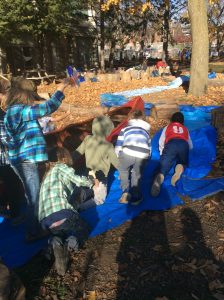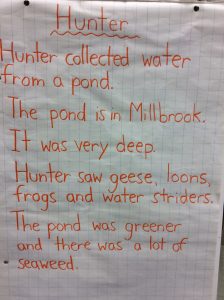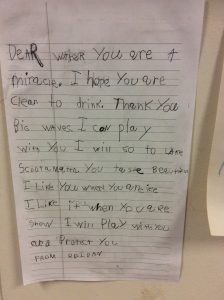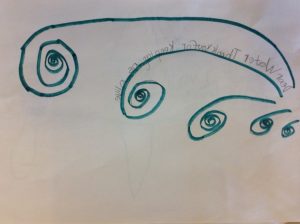I have been learning with, from, and about water for several years. In another blog, I shared examples of what decolonial water pedagogy might look like in a Grade 2 classroom. Whenever possible, it is critically important to invite Indigenous artists, activists, and Earth workers to share their knowledge with students in their own voices.
Water is Life:
This fall, the Grade 2-6 students participated in a workshop with Joce Two-Crows Tremblay and Faye Mullen called “Water is Life”. They describe the workshop as: “Wondering on water as an ancestral highway, as home, as Medicine and more, through story, song and ceremony.”
It was a beautiful morning. We gathered in a circle and welcomed our special guests with the song, “Funga Alafia”. Archer Pechawis, a Grove parent, joined us and shared songs and drumming. We offered tobacco and gratitude for their teachings.
Joce taught us about the strong connections between language and land. We learned about the Indigenous roots of many words spoken in English. After the workshop, I asked the Grade 2 students to document their new learning on inquiry cards with the prompt, “Now I know….”.
NOW I KNOW….
…that Toronto is pronounced many different ways. SOL
…that Lake Ontario in the Indigenous language is “Lake Handsome Lake.” DEMA
Water as Relative:
After a discussion about the importance of water and who we consider to be our relatives, we learned about the relationship between salmon, people, and water. When young children see themselves in relationships with land that are rooted in reciprocity and respect, they might care for all humans and more-than-humans as family. 
Water as Ancestral Highway:
In preparation for the workshop, everyone had made salmon puppets, and we re-created water using tarps and blue material. As Joce and Faye paddled up the river, singing an Anishinaabe Water song, our salmon puppets swam upstream to spawn.
NOW I KNOW….
…a song about water. GWEN
…that people sing river songs to catch up to salmon. CLEM
At the end of our journey, we learned more about how Anishinaabeg used land as tools and technology in innovative ways.
NOW I KNOW…
...how to catch salmon, and when to. DESMOND
…people put Willows down to trap big salmon. SVEA
Water as Medicine:
We ended our workshop with a Water Ceremony. We sat in a circle and water was poured into our cup. As we held water in our hands, Joce and Faye invited us to think about how living things can feel and absorb our energy, and that is why we must be aware and intentional about our relationship to land. We were encouraged to send greetings of love and hope and gratitude to the water. After sitting quietly and reflecting, we drank from our cup and wondered if the taste of the water was affected by our ceremony.
NOW I KNOW….
…water can hold lots of energy. LOTE
…water gives life to everything. ELLIOT
It was a powerful morning. We learned many important lessons about land and language, connection and community, technology and teachings. Everyone enjoyed learning outside with and from the land, through storytelling, movement and music. Thank you to Joce, Faye and Archer for sharing your knowledge with us.


















